
Recommended Reading List 6
Significant Stories - There are many stories to be told of and by the man and women who served in the Pacific war. It is essential that their stories be preserved and remembered by succeeding generations.
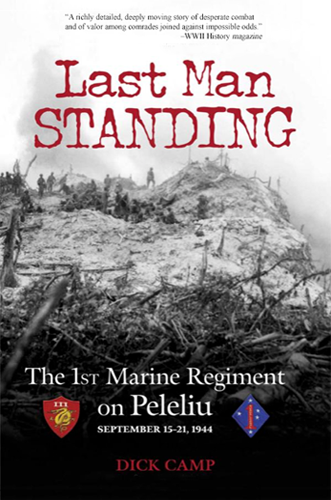
Last Man Standing: The 1st Marine Regiment on Peleliu, September 15-21, 1944
Dick Camp
One of the bloodiest battles in Marine Corps history, Operation Stalemate, as Peleliu was called, was overshadowed by the Normandy landings. It was also, in time, judged by most historians to have been unnecessary; though it had been conceived to protect MacArthur’s flank in the Philippines, the U.S. fleet’s carrier raids had eliminated Japanese airpower, rendering Peleliu irrelevant. Nevertheless, the horrifying number of casualties sustained there (71% in one battalion) foreshadowed for the rest of the war: rather than fight to the death on the beach, the Japanese would now defend in depth and bleed the Americans white.
Drawing extensively on personal interviews, the Marine Corps History Division’s vast oral history and photographic collection, and many never-before-published sources, this book gives us a new and harrowing vision of what really happened at Peleliu--and what it meant. Working closely with two of the 1st Regiment’s battalion commanders--Ray Davis and Russ Honsowetz--Marine Corps veteran and military historian Dick Camp recreates the battle as it was experienced by the men and their officers. Soldiers who survived the terrible slaughter recall the brutality of combat against an implacable foe; they describe the legendary “Chesty” Puller, leading his decimated regiment against enemy fortifications; they tell of Davis, wounded but refusing evacuation while his men were under fire; and of a division commander who rejects Army reinforcements. Most of all, their richly detailed, deeply moving story is one of desperate combat in the face of almost certain failure, of valor among comrades joined against impossible odds.
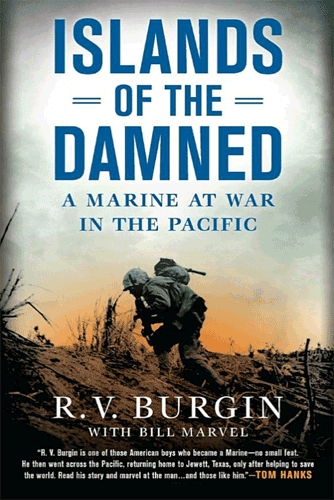
Islands of the Damned: A Marine at War in the Pacific
R. V. Burgin with Bill Marvel
A remarkable eyewitness account of the most brutal combat of the Pacific War, from Peleliu to Okinawa, this is the true story of R.V. Burgin, the real-life World War II Marine Corps hero featured in HBO's The Pacific.
“Read his story and marvel at the man...and those like him.”—Tom Hanks
This is an eyewitness-and eye-opening-account of some of the most savage and brutal fighting in the war against Japan, told from the perspective of a young Texan who volunteered for the Marine Corps to escape a life as a traveling salesman. R.V. Burgin enlisted at the age of twenty, and with his sharp intelligence and earnest work ethic, climbed the ranks from a green private to a seasoned sergeant. Along the way, he shouldered a rifle as a member of a mortar squad. He saw friends die-and enemies killed. He saw scenes he wanted to forget but never did-from enemy snipers who tied themselves to branches in the highest trees, to ambushes along narrow jungle trails, to the abandoned corpses of hara kiri victims, to the final howling banzai attacks as the Japanese embraced their inevitable defeat.
_____
USS Elmore is mentioned several times throughout the book.
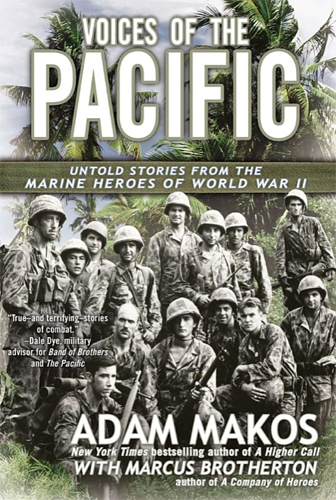
Voices of the Pacific: Untold Stories from the Marine Heroes of World War II
Adam Makos
Following fifteen Marines from the Pearl Harbor attack, through battles with the Japanese, to their return home after V-J Day, Adam Makos and Marcus Brotherton have compiled an oral history of the Pacific War in the words of the men who fought on the front lines. With unflinching honesty, these Marines reveal harrowing accounts of combat with an implacable enemy, the friendships and camaraderie they found—and lost—and the aftermath of the war’s impact on their lives.
With unprecedented access to the veterans, rare photographs, and unpublished memoirs, Voices of the Pacific presents true stories of heroism as told by such World War II veterans as Sid Phillips, R. V. Burgin, and Chuck Tatum—whose exploits were featured in the HBO® miniseries, The Pacific—and their Marine buddies from the legendary 1st Marine Division.
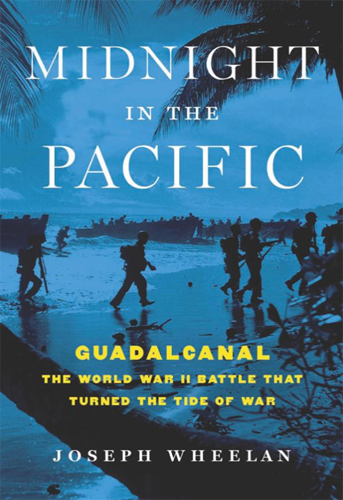
Midnight in the Pacific: Guadalcanal--The World War II Battle That Turned the Tide of War
Joseph Whellan
From early August until mid-November of 1942, US Marines, sailors, and pilots struggled for dominance against an implacable enemy: Japanese soldiers, inculcated with the bushido tradition of death before dishonor, avatars of bayonet combat--close-up, personal, and gruesome. The glittering prize was Henderson Airfield. Japanese planners knew that if they neutralized the airfield, the battle was won. So did the Marines who stubbornly defended it.
The outcome of the long slugfest remained in doubt under the pressure of repeated Japanese air, land, and sea operations. And losses were heavy. At sea, in a half-dozen fiery combats, the US Navy fought the Imperial Japanese Navy to a draw, but at a cost of more than 4,500 sailors. More American sailors died in these battles off Guadalcanal than in all previous US wars, and each side lost 24 warships. On land, more than 1,500 soldiers and Marines died, and the air war claimed more than 500 US planes. Japan's losses on the island were equally devastating--starving Japanese soldiers called it "the island of death."
But when the attritional struggle ended, American Marines, sailors, and airmen had halted the Japanese juggernaut that for five years had whirled through Asia and the Pacific. Guadalcanal was America's first major ground victory against Japan and, most importantly, the Pacific War's turning point.
Published on the 75th anniversary of the battle and utilizing vivid accounts written by the combatants at Guadalcanal, along with Marine Corps and Army archives and oral histories, Midnight in the Pacific is both a sweeping narrative and a compelling drama of individual Marines, soldiers, and sailors caught in the crosshairs of history.
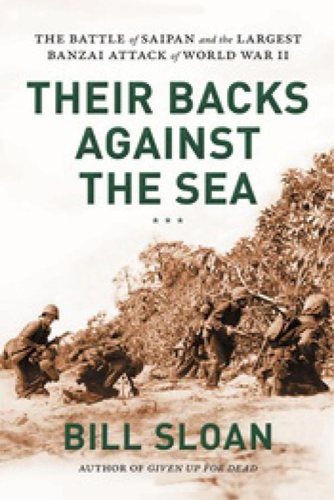
Their Backs against the Sea: The Battle of Saipan and the Largest Banzai Attack of World War II
Bill Sloan
In the midst of the largest banzai attack of the war, US Army Lt. Col. William O'Brien, grievously wounded and out of ammunition, grabbed a sabre from a fallen Japanese soldier and flailed away at a small army of assailants, screaming to his men, "Don't give them a damn inch!" When his body was recovered the next day, thirty dead enemies were piled around him.
The Battle of Saipan lasted twenty-five hellish days in the summer of 1944, and the stakes couldn't have been higher. If Japan lost possession of the island, all hope for victory would be lost. For the Americans, its capture would result in secure air bases for the new B-29s that would put them within striking distance of the Japanese homeland. The outcome of the war in the Pacific lay in the balance.
In this gritty, vivid narrative, award-winning author Bill Sloan fuses fresh interviews, oral and unit histories, and unpublished accounts to describe one of the war's bloodiest and most overlooked battles of the Pacific theater. Combining grunt's-view grit with big picture panorama (and one of the ugliest inter-service controversies of the war), Their Backs against the Sea is the definitive dramatic story of this epic battle--and an inspiring chronicle of some of the greatest acts of valor in American military history.
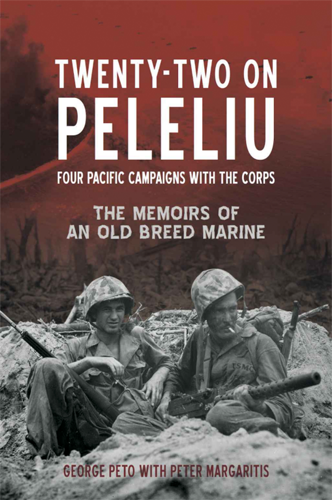
Twenty-Two on Peleliu: Four Pacific Campaigns with the Corps: The Memoirs of an Old Breed Marine
George Peto
On September 15, 1944, the U.S. First Marine Division landed on a small island in the Central Pacific called Peleliu as a prelude to the liberation of the Philippines. Among the first wave of Marines that hit the beach that day was 22-year-old George Peto.
Following boot camp and training, he was initially assigned to various guard units, until he was shipped out to the Pacific and assigned to the 1st Marines. His first combat experience was the landing at Finschhaven, followed by Cape Gloucester. Then as a Forward Observer, he went ashore in one of the lead amtracs at Peleliu and saw fierce fighting for a week before the regiment was relieved due to massive casualties. Six months later, his division became the immediate reserve for the initial landing on Okinawa. They encountered no resistance when they came ashore on D+1, but would go on to fight on Okinawa for over six months.
This is the wild and remarkable story of an "Old Breed" Marine, from his youth in the Great Depression, his training and combat in the Pacific, to his life after the war, told in his own words.
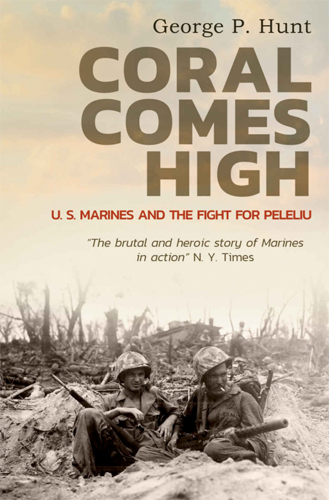
Coral Comes High: U. S. Marines and the Fight for Peleliu
George P. Hunt
Coral Comes High is Captain George P. Hunt's account of what happened to himself and his company during the initial stages of the Peleliu invasion by the US Marines during World War 2. The company sustains terrible casualties and is isolated in a seemingly hopeless position for a nightmare forty-eight hours. Outnumbered and outgunned by the enemy, they beat off all attacks and seize the Point with a courage which is at the same time matter-of-fact and almost superhuman.
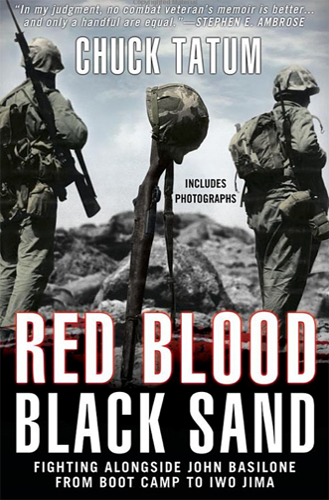
Red Blood, Black Sand: Fighting Alongside John Basilone from Boot Camp to Iwo Jima
Chuck Tatum
In 1944, the U.S. Marines were building the 5th Marine Division—also known as “The Spearhead”—in preparation for the invasion of the small, Japanese-held island of Iwo Jima...
When Chuck Tatum began Marine boot camp, he was just a smart-aleck teenager eager to serve his country. Little did he know that he would be training under a living legend of the Corps—Medal of Honor recipient John Basilone, who had almost single-handedly fought off a Japanese force of three thousand on Guadalcanal.
It was from Basilone and other sergeants that Tatum would learn how to fight like a Marine and act like a man—skills he would need when he hit the black sand of Iwo Jima with thirty thousand other Marines.
Red Blood, Black Sand is the story of Chuck’s two weeks in hell, where he would watch his hero, Basilone, fall, where the enemy stalked the night, where snipers haunted the day, and where Chuck would see his friends whittled away in an eardrum-shattering, earth-shaking, meat grinder of a battle. This is the island, the heroes, and the tragedy of Iwo Jima—through the eyes of one who survived it.
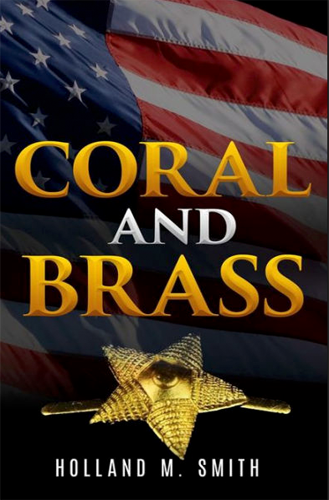
Coral And Brass
Holland M. Smith
This story possesses all the explosive vigor and forthrightness that made General "Howlin Mad" Smith famous. He pulls no punches, either in his fighting man's tale of the Pacific War, or in demanding full recognition for his Marines. It is his personal story of the Marine Corps' achievement in the war with Japan.
The aim of Smith's book is twofold: first, that due credit be given to a gallant body of men, the United States Marine Corps, who in their path across the Pacific were faithful to their traditions and to their country; second, to point out the errors that were committed in World War II in such a manner that they will not be repeated in World War III — God forbid. This is a personalized account of over forty years in the service of his country, culminating in the greatest war in our history. Smith never kept a diary. He had no official historian at my elbow recording in detail the battles that he fought. Understandably, the general was too busy fighting those battles to set down anything in chronological form. As he noted: "I find myself largely relying on my memory to compile the story of those forty years. If I have erred in facts, it is due to the momentous times through which I have lived and served. I bear no malice toward any man or any Service. Any criticism in this book is made only for constructive purposes in the light of national defense needs. I am sure that a grateful country will not forget the magnificent efforts made by the Marines in the Pacific for the successful prosecution of the war against Japan."
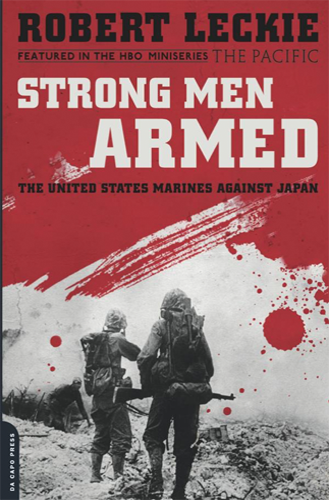
Strong Men Armed: The United States Marines Against Japan
Robert Leckie
Written by Robert Leckie, whose wartime exploits were featured in the Tom Hanks/Steven Spielberg HBO miniseries The Pacific, Strong Men Armed has been a perennial bestselling classic account of the Pacific theater in World War II. As scout and machine-gunner for the First Marine Division, Leckie fought in all its engagements until his wounding at Peleliu. Here he uses firsthand experience and impeccable research to re-create the nightmarish battles of the Pacific campaign.
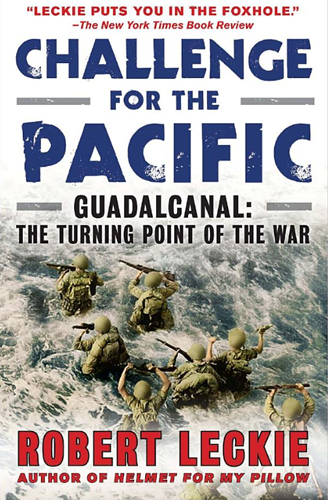
Challenge for the Pacific: Guadalcanal: The Turning Point of the War
Robert Leckie
From the Japanese soldiers’ carefully calculated—and ultimately foiled—attempt to build a series of impregnable island forts on the ground to the tireless efforts of the Americans who struggled against a tenacious adversary and the temperature and terrain of the island itself, Robert Leckie captures the loneliness, the agony, and the heat of twenty-four-hour-a-day fighting on Guadalcanal. Combatants from both sides are brought to life: General Archer Vandegrift, who first assembled an amphibious strike force; Isoroku Yamamoto, the naval general whose innovative strategy was tested; the island-born Allied scout Jacob Vouza, who survived hideous torture to uncover the enemy’s plans; and Saburo Sakai, the ace flier who shot down American planes with astonishing ease.
Propelling the Allies to eventual victory, Guadalcanal was truly the turning point of the war. Challenge for the Pacific is an unparalleled, authoritative account of this great fight that forever changed our world.
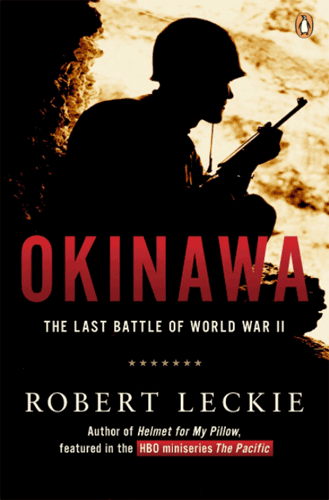
Okinawa: The Last Battle of World War II
Robert Leckie
Former Marine and Pacific War veteran Robert Leckie tells the story of the invasion of Okinawa, the closing battle of World War II. Leckie is a skilled military historian, mixing battle strategy and analysis with portraits of the men who fought on both sides to give the reader a complete account of the invasion. Lasting 83 days and surpassing D-Day in both troops and material used, the Battle of Okinawa was a decisive victory for the Allies, and a huge blow to Japan. In this stirring and readable account, Leckie provides a complete picture of the battle and its context in the larger war.

